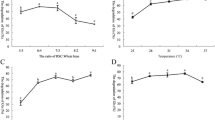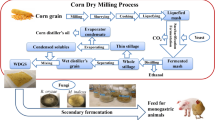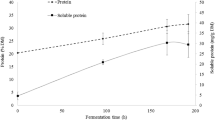Abstract
The present research describes the use of Rhizopus oryzae as bioconversion agent of different agro-industrial by-products (fruit wastes, olive pulp cake, coffee grounds and potato peels) by solid state fermentation at different experimental conditions to enhance their value as animal feed. Results showed that R. oryzae grows better at fruit wastes than in other by-products. Fermentation process produced a protein and fat rich mycelia [respectively, 7.8 ± 1.2 and 9.0 ± 0.4% of dry matter (DM)] and reduced the carbohydrates content of considered by-products from 60.6 ± 0.4 to 40.1 ± 0.3% DM in 3 days. Supplementation with different nitrogen sources increases dramatically the protein concentration in the mycelia up to 46.8 ± 0.7% of DM. After fermentation, amino acid profile changed in the fermented product, with significant enrichment of several essential amino acids like valine, leucine, threonine, isoleucine and arginine and lower aspartate concentration. In conclusion, obtained product can be a high value alternative for animal feed.




Similar content being viewed by others
References
Stenmarck, Å., Jensen, C., Quested, T., Moates, G.: Estimates of European food waste levels. In: European Commission, Coordination and Support Action Stockholm, (2016)
Villas-Boas, S.G., Esposito, E., Mitchell, D.A.: Microbial conversion of lignocellulosic residues for production of animal feeds. Anim. Feed Sci. Technol. 98(1–2), 1–12 (2002)
Ugwuanyi, J.O., McNeil, B., Harvey, L.M.: Production of protein-enriched feed using agro-industrial residues as substrates. In: nee´Nigam, P.S., Pandey, A. (eds.) Biotechnology for Agro-Industrial Residues Utilisation, pp. 77–104. Springer, New York, (2009)
Couto, S.R., Sanromán, M.Á.: Application of solid-state fermentation to food industry—a review. J. Food Eng. 76(3), 291–302 (2006)
Budziszewska, J., Wilk, M., Wrzosek, M.: Taxonomic revision of the genus Rhizomucor. Paper presented at the IMC9: The Biology of Fungi, Edinburgh, UK
Cantabrana, I., Perise, R., Hernández, I.: Uses of Rhizopus oryzae in the kitchen. Int. J. Gastron. Food Sci. 2(2), 103–111 (2015)
Hachmeister, K.A., Fung, D.Y.C: Tempeh: a mold-modified indigenous fermented food made from soybeans and/or cereal grains. Crit. Rev. Microbiol. 19(3), 137–188 (1993)
Lv, X.C., Huang, Z.Q., Zhang, W., Rao, P.F., Ni, L.: Identification and characterization of filamentous fungi isolated from fermentation starters for Hong Qu glutinous rice wine brewing. J. Gen. Appl. Microbiol. 58(1), 33–42 (2012)
Ghosh, B., Ray, R.R.: Extra-cellular isoamylase production by Rhizopus oryzae in solid-state sermentation of agro wastes. Braz. Arch. Biol. Technol. 54(5), 867–876 (2011)
Kim, H.-R., Kim, J.-H., Bai, D.-H., Ahn, B.-H.: Identification and characterization of useful fungi with alpha-amylase activity from the Korean traditional Nuruk. Mycobiology 39(4), 278–282 (2011)
Bakir, U., Sebnem, Y., Ferda, G., Aysegul, E.: An endo-1,4-xylanase from Rhizopus oryzae: production, partial purification and biochemical characterization. Enzym. Microb. Technol. 29, 328–334 (2001)
Benoit, I., Coutinho, P.M., Schols, H.A., Gerlach, J.P., Henrissat, B., de Vries, R.P.: Degradation of different pectins by fungi: correlations and contrasts between the pectinolytic enzyme sets identified in genomes and the growth on pectins of different origin. BMC Genomics 13, 321 (2012)
Saito, K., Takakuwa, N., Oda, Y.: Purification of the extracellular pectinolytic enzyme from the fungus Rhizopus oryzae NBRC 4707. Microbiol. Res. 159(1), 83–86 (2004)
Karmakar, M., Ray, R.R.: Extra celullar endoglucanase production by Rhizopus oryzae in solid and liquid state fermentation of agro wastes. Asian J. Biotechnol. 2, 27–36 (2010)
Kupski, L., de Carvalho Silvello, M.A., Fontes, M.R.V., Lima, T.S., Treichel, H., Badiale Furlong, E.: R. oryzae cellulases: a new approach to degrading lignocellulosic material. J. Food Biochem. 39(2), 129–138 (2015)
Liao, W., Liu, Y., Frear, C., Chen, S.: Co-production of fumaric acid and chitin from a nitrogen-rich lignocellulosic material—dairy manure—using a pelletized filamentous fungus Rhizopus oryzae ATCC 20344. Bioresour. Technol. 99(13), 5859–5866 (2008)
Wang, G., Huang, D., Li, Y., Wen, J., Jia, X.: A metabolic-based approach to improve xylose utilization for fumaric acid production from acid pretreated wheat bran by Rhizopus oryzae. Bioresour. Technol. 180, 119–127 (2015)
Xu, Q., Li, S., Fu, Y., Tai, C., Huang, H.: Two-stage utilization of corn straw by Rhizopus oryzae for fumaric acid production. Bioresour. Technol. 101(15), 6262–6264 (2010)
Das, R.K., Brar, S.K., Verma, M.: A fermentative approach towards optimizing directed biosynthesis of fumaric acid by Rhizopus oryzae 1526 utilizing apple industry waste biomass. Fungal Biol. 119(12), 1279–1290 (2015)
Gunawan-Puteri, M.D.P.T., Hassanein, T.R., Prabawati, E.K., Wijaya, C.H., Mutukumira, A.N.: Sensory characteristics of seasoning powders from overripe tempeh, a solid state fermented soybean. Procedia Chem. 14, 263–269 (2015)
M’hir, S., Mejri, A., Sifaoui, I., Slama, M.B., Mejri, M., Thonart, P., Hamdi, M.: Improvement of protease production by Rhizopus oryzae CH4 grown on wheat. Arch. App. Sci. Res. 4(2), 1110–1116 (2012).
Lopez, E., Deive, F.J., Longo, M.A., Sanroman, M.A.: Strategies for utilisation of food-processing wastes to produce lipases in solid-state cultures of Rhizopus oryzae. Bioprocess Biosyst. Eng. 33(8), 929–935 (2010)
Christen, P., Bramorski, A., Revah, S., Soccol, C.R.: Characterization of volatile compounds produced by Rhizopus strains grown on agro-industrial solid wastes. Bioresour. Technol. 71(3), 211–215 (2000)
Hamdy, H.S.: Production of mini-food by Aspergillus niger, Rhizopus oryzae and Saccharomyces cerevisiae using orange peels. Rom. Biotech. Lett. 18(1), 7929–7946 (2013)
Oliveira, M.D.S., Feddern, V., Kupski, L., Cipolatti, E.P., Badiale-Furlong, E., de Souza-Soares, L.A.: Physico-chemical characterization of fermented rice bran biomass Caracterización fisico-química de la biomasa del salvado de arroz fermentado. CyTA J. Food 8(3), 229–236 (2010)
Musa, R., Yunoki, K., Kinoshita, M., Oda, Y., Ohnishi, M.: Increased levels of policosanol and very long-chain fatty acids in potato pulp fermented with Rhizopus oryzae. Biosci. Biotechnol. Biochem. 68(11), 2401–2404 (2004)
Massarolo, K.C., de Souza, T.D., Ribeiro, A.C., Furlong, E.B., de Souza Soares, L.A.: Influence of cultivation Rhizopus oryzae on rice bran on lipid fraction: fatty acids and phospholipids. Biocatal. Agric. Biotechnol. 8, 204–208 (2016)
Hackbart, H.C.S., Machado, A.R., Christ-Ribeiro, A., Prietto, L., Badiale-Furlong, E.: Reduction of aflatoxins by Rhizopus oryzae and Trichoderma reesei. Mycotoxin Res. 30(3), 141–149 (2014)
Soccol, C.R., Iloki, I., Marin, B., Raimbault, M.: Comparative production of alpha-amylase, glucoamylase and protein enrichment of raw and cooked cassava by Rhizopus strains in submerged and solid-state fermentations. J. Food Sci. Technol. 31(4), 320–323 (1994)
Robinson, T., Nigam, P.: Bioreactor design for protein enrichment of agricultural residues by solid state fermentation. Biochem. Eng. J. 13(2–3), 197–203 (2003)
Ferreira, J.A., Lennartsson, P.R., Niklasson, C., Lundin, M., Edebo, L., Taherzadeh, M.J.: Spent sulphite liquor for cultivation of an edible Rhizopus sp. BioResources 7(1), 173–188 (2012)
Calidad, C.d.I.y.C.d.l.: Análisis de alimentos: métodos oficiales y recomendados por el Centro de Investigación y Control de la Calidad. In: Consumo, M.d.S.y. (ed.). p. 1015. Ministerio de Sanidad y Consumo, (1985)
Mamma, D., Topakas, E., Vafiadi, C., Christakopoulos, P.: Biotechnological potential of fruit processing industry residues. In: nee´Nigam, P.S., Pandey, A. (eds.) Biotechnology for Agro-Industrial Residues Utilisation, pp. 273–291. Springer, New York (2009)
Vendruscolo, F., da Silva Ribeiro, C., Esposito, E., Ninow, J.L.: Protein enrichment of apple pomace and use in feed for Nile tilapia. Appl. Biochem. Biotechnol. 152(1), 74–87 (2009)
Usaquen, S.M.: Aprovechamiento y valorización del alpeorujo tratado termicamente como: fertilizante biológco y fuente de hidroxitirosol Pontifia Universidad Javeriana (2008)
Kupski, L., Cipolatti, E., da Rocha, M., Oliveira, M.D., Souza-Soares, L.D., Badiale-Furlong, E.: Solid-state fermentation for the enrichment and extraction of proteins and antioxidant compounds in rice bran by Rhizopus oryzae. Braz. Arch. Biol. Technol. 55(6), 937–942 (2012)
Lennartsson, P.R., Taherzadeh, M.J., Edebo, L.: Rhizopus. In: Encyclopedia of food microbiology. Reference module in food safety, pp. 284–290. (2014).
Huang, L.P., Jin, B., Lant, P., Zhou, J.: Simultaneous saccharification and fermentation of potato starch wastewater to lactic acid by Rhizopus oryzae and Rhizopus arrhizus. Biochem. Eng. J. 23(3), 265–276 (2005).
Oboh, G., Elusiyan, C.A.: Changes in the nutrient and anti-nutrient content of micro-fungi fermented cassava flour produced from low- and medium-cyanide variety of cassava tubers. Afr. J. Biotechnol. 6(18), 2150–2157 (2007)
Kayode, R.M.O., Sani, A.: Mineral compositions and amino acid profile of mono-culture fungal fermented mango (Mangifera Indica) kernel cake. J. Agric. Sci. 2(3), 69–74 (2010)
Yunoki, K., Musa, R., Kinoshita, M., Oda, Y., Ohnishi, M.: Determinations of triacylglycerol and fatty acid esters in potato pulp fermented with lactic acid-producing fungus. J. Oil Chem. Soc. Jpn. 53(11), 565–569 (2004)
Oliveira, M.D., Feddern, V., Kupski, L., Cipolatti, E.P., Badiale-Furlong, E., de Souza-Soares, L.A.: Changes in lipid, fatty acids and phospholipids composition of whole rice bran after solid-state fungal fermentation. Bioresour. Technol. 102(17), 8335–8338 (2011)
Oda, Y., Yajima, Y., Kinoshita, M., Ohnishi, M.: Differences of Rhizopus oryzae strains in organic acid synthesis and fatty acid composition. Food Microbiol. 20(3), 371–375 (2003)
Devrajan, A., Joshi, V.K., Gupta, K., Sheikher, C., Lal, B.B.: Evaluation of apple pomace based reconstituted feed in rats after solid state fermentation and ethanol recovery. Braz. Arch. Biol. Technol. 47(1), 93–106 (2004)
Joshi, V.K., Sandhu, D.K.: Preparation and evaluation of an animal feed byproduct produced by solid-state fermentation of apple pomace. Bioresour. Technol. 56(2–3), 251–255 (1996)
Upadhyaya, S., Tiwari, S., Arora, N., Singh, D.P.: Microbial protein: a valuable component for future food security. In: Singh, J.S., Singh, D.P. (eds.) Microbes and Environmental Management. Studium Press, New Delhi (2016)
FAO/WHO: Energy and Protein Requirements, pp. 1–118. WHO, Geneva (1973)
Wu, G., Bazer, F.W., Dai, Z., Li, D., Wang, J., Wu, Z.: Amino acid nutrition in animals: protein synthesis and beyond. Annu. Rev. Anim. Biosci. 2, 387–417 (2014)
Verdú, J.M.: Tabla de composición de alimentos, 5 edn. Granada (2009)
Acknowledgements
Authors thank to Ainhoa Bikandi and Pilar Martín for their excellent technical support and to Sociedad Cooperativa “La Milagrosa” and Ekogras for providing the substrates. This work was funded by the Basque Government (Department of the Environment, Regional Planning, Agriculture and Fisheries).
Author information
Authors and Affiliations
Corresponding author
Rights and permissions
About this article
Cite this article
Ibarruri, J., Hernández, I. Rhizopus oryzae as Fermentation Agent in Food Derived Sub-products. Waste Biomass Valor 9, 2107–2115 (2018). https://doi.org/10.1007/s12649-017-0017-8
Received:
Accepted:
Published:
Issue Date:
DOI: https://doi.org/10.1007/s12649-017-0017-8




